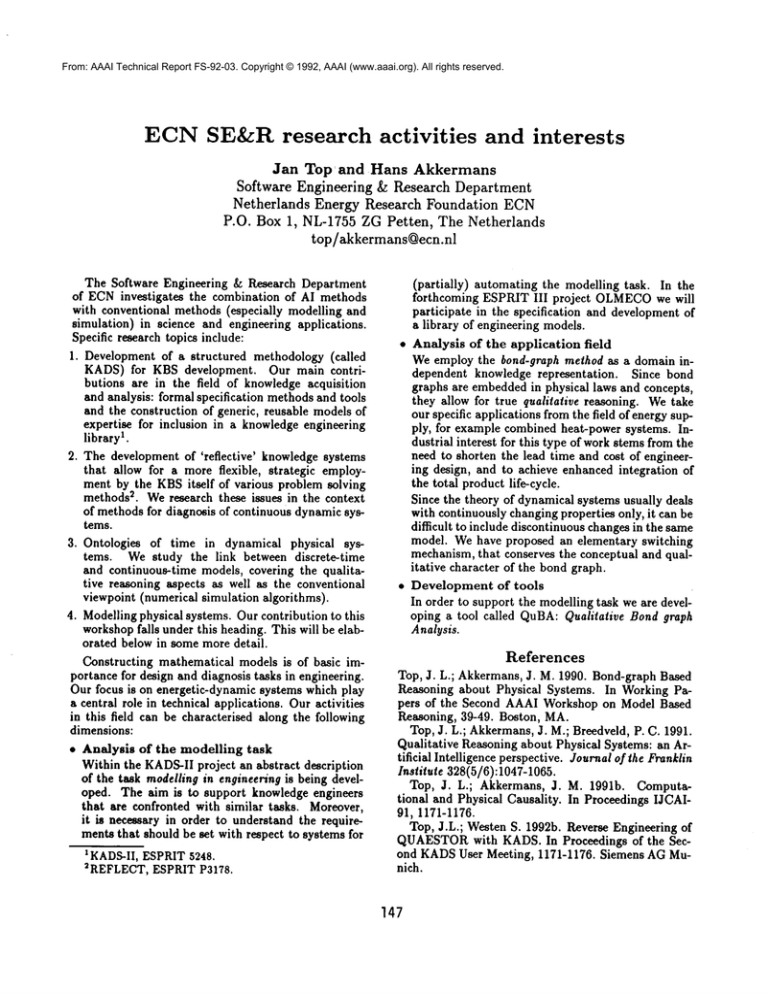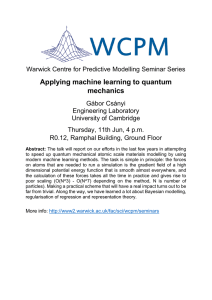
From: AAAI Technical Report FS-92-03. Copyright © 1992, AAAI (www.aaai.org). All rights reserved.
ECN SE&Rresearch
activities
and interests
Jan Top and Hans Akkermans
Software Engineering
& Research Department
Netherlands
Energy Research
Foundation
ECN
P.O. Box 1, NL-1755 ZG Petten,
The Netherlands
top/akkermans@ecn.nl
The Software Engineering & Research Department
of ECNinvestigates the combination of AI methods
with conventional methods (especially modelling and
simulation) in science and engineering applications.
Specific research topics include:
1. Development of a structured methodology (called
KADS) for KBS development. Our main contributions are in the field of knowledge acquisition
and analysis: formal specification methods and tools
and the construction of generic, reusable models of
expertise for inclusion in a knowledge engineering
1.
library
2. The development of ’reflective’
knowledge systems
that allow for a more flexible, strategic employment by the KBSitself of various problem solving
methods~. Weresearch these issues in the context
of methods for diagnosis of continuous dynamic systems.
3. Ontologies of time in dynamical physical systems. We study the link between discrete-time
and continuous-time models, covering the qualitative reasoning aspects as well as the conventional
viewpoint (numerical simulation algorithms).
4. Modelling physical systems. Our contribution to this
workshopfalls under this heading. This will be elaborated below in some more detail.
Constructing mathematical models is of basic importance for design and diagnosis tasks in engineering.
Our focus is on energetic-dynamic systems which play
a central role in technical applications. Our activities
in this field can be characterised along the following
dimensions:
¯ Analysis of the modelling task
Within the KADS-IIproject an abstract description
of the task modelling in engineering is being developed. The aim is to support knowledge engineers
that are confronted with similar tasks. Moreover,
it is necessary in order to understand the requirements that should be set with respect to systems for
a KADS-II, ESPRIT5248.
2REFLECT,ESPRIT P3178.
(partially)
automating the modelling task. In the
forthcoming ESPRIT III project OLMECO
we will
participate in the specification and development of
a library of engineering models.
¯ Analysis of the application field
Weemploy the bond-graph method as a domain independent knowledge representation.
Since bond
graphs are embeddedin physical laws and concepts,
they allow for true qualitative reasoning. Wetake
our specific applications from the field of energy supply, for example combined heat-power systems. Industrial interest for this type of work stems from the
need to shorten the lead time and cost of engineering design, and to achieve enhanced integration of
the total product life-cycle.
Since the theory of dynamical systems usually deals
with continuously changing properties only, it can be
difficult to include discontinuous changes in the same
model. We have proposed an elementary switching
mechanism, that conserves the conceptual and qualitative character of the bond graph.
¯ Development of tools
In order to support the modelling task we are developing a tool called QuBA:Qualitative Bond graph
Analysis.
References
Top, J. L.; Akkermans, J. M. 1990. Bond-graph Based
Reasoning about Physical Systems. In Working Papers of the Second AAAIWorkshop on Model Based
Reasoning, 39-49. Boston, MA.
Top, J. L.; Akkermans,J. M.; Breedveld, P. C. 1991.
Qualitative Reasoning about Physical Systems: an Artificial Intelligence perspective. Journal of the Franklin
Institute 328(5/6):1047-1065.
Top, J. L.; Akkermans, J. M. 1991b. Computational and Physical Causality. In Proceedings IJCAI91, 1171-1176.
Top, J.L.; Westen S. 1992b. Reverse Engineering of
QUAESTOR
with KADS. In Proceedings of the Second KADSUser Meeting, 1171-1176. Siemens AG Munich.
147
From: AAAI Technical Report FS-92-03. Copyright © 1992, AAAI (www.aaai.org). All rights reserved.
TheoJ.A. de Vries, University of Twente, EE department, Control Laboratory, P.O.Box 217, 7500 AE
Enschede,Netherlands, phone: +31 - 53 - 892788,e-mail vri@rt.el.utwente.nl
In our group, the modelling of the dynamicbehaviour of (macro-)physical systems in general
studied, also on the basis of a wide range of applications. The basic philosophy behind this research is
the recognition that there is more to modellingthan "simply" deriving a set of differential equations. The
behaviour of energy and powerin physical systems is chosen as a guide in the process of establishing the
non-causal (!) relations between the subsystems and elements of a system. This guide appears to be
useful instrument for all physical domains. Based upon this, a multidiscplinary model-description
language is applied. This language describes the relations between subsystems and elements as they
exist, i.e. simultaneously instead of sequentially. This meansthat the language has to have a graphical
nature, because descriptive languages, mathematical equations included, are always of a sequential
nature. The graphical language or "knowledge representation" used for the description of physical
systems is called "bond graphs" and has been developed further by the group into "generalized bond
graphs" in a so-called "multibond graph notation", which can be used, for instance, to describe
multidimensional systems.
Within this context, I am working on a project in which it is researched how modelling and
simulation techniques and expertise can be used to enhance (conceptual) design. This project is done
coorporation with Unilever Research Laboratories, Vlaardingen, Netherlands. Research results are
evaluated and tested in the real world design practice, focussing on the design of controlled product
handling systems, in particular collating systems.
A theory applicable to both design [1] and modelling [2] has been formulated on basis of a
hypothesis about the modelling aspects of the object of interest. Knowledgebased support for modelling
and designing product handling machines is developed from the perspective of this theory. The
developed system [3] demonstrates that modelling formalisms and techniques are useful in order to
create deep models which capture engineering meaningin a way appropriate for designing. Furthermore
the implementation shows that bond graphs play an important role as the kernel of the system and as a
powerful language for describing and classifying physical principles across domains(thereby linking
function to form). However, bond graphs only capture a part of the aspects in which a designer is
interested during conceptual design, i.e. additional representations are needed.
The main reasoning capabilities whichthe system currently features are the abilities to represent a
model cor~istently in multiple ways (namely schematic diagrams and bond graphs), and the possibility
to automatically transform one representation to another, regardless of complexity [4]. Furthermore
powerful reasoning capabilities will becomeavailable with regard to causality. Causal analysis gives the
modeller or designer insight into the problem and proposed solution, and is essential whensimulating
complex dynamical systems.
References
[1] De Vries, T.J.A., P.C. Breedveld and J. van Amerongen,A design theory for classification and
development of CAEsystems, Symposiumon Automated Modelling, Proc. ASMEWinter Annual
Meeting’91 (Atlanta, U.S.A.), DSC-Vol.34, 1991, pp 37-44
[2] De Vries, T.J.A. andP.C. Breedveld, A modelof the modelling process, Bondgraphs for engineers,
G. Dauphin-Tanguyand P.C. Breedveld (eds.), Elsevier, Amsterdam1992, pp 291-302
[3] Van Dijk, J., T.J.A. de Vries, A.P.J. Breunese and P.C. Breedveld, Automated mechatronic
systems modelling, to be published in Bond graphs for engineers, G. Dauphin-Tanguyand P.C.
Breedveld (eds.), Elsevier, Amsterdam1992, pp 269-280
[4] Breunese, A.P.J., Design and implementation of a mechatronic modelling environment using
object oriented principles, MScthesis no 92R071, Control Laboratory, University of Twente,
Enschede, Netherlands, 1992
148



